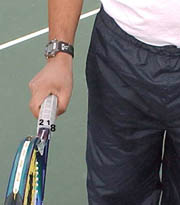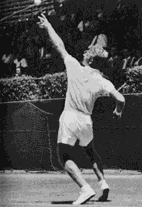|
TennisOne Lessons
At the 1999 US Open, Mark Woodforde was
served off the court in the first round by Goran Ivanisevic.
At the press conference, Woodforde took a swipe (too little too
late) at Ivanisevic, saying his game was boring because he could
never really read the lefty's delivery. That comment struck me,
so I have interviewed many coaches and players in the interim,
trying to get a handle on what it means to "disguise"
a serve. On the surface, a disguised serve, is one
where the receiver cannot pick the direction of the serve until
it is too late to move to the ball. Often, such a disguised serve
leaves the receiver flat footed. But on a deeper level, how are
serves disguised, do all the professionals serve with equal disguise,
what are the keys you might observe when watching the matches,
or when practicing the serve yourself ? The GripPancho Gonzalez was the acknowledged maestro
of the serve. In Tennis Begins at 40 - an excellent book by Pancho
Gonzalez and Jeffrey Barstow he recommended using a backhand
grip for all serves, and especially the slice I attended the USTA 3.0 Senior National
tournament with our club team in 1998, and noticed the truly
outstanding servers at the tournament (perhaps 4 or 5 guys) all
used the backhand grip. And the players who faced these servers
all had a devil of a time reading the ball and reacting to the
spin and action of the serve. The Mentality
Frank Brennan, notoriously successful coach
of the Stanford Womens Team, likens the servers mentality to
that of a pitcher. Pitchers avoid falling into a pattern, mixing
up the fast ball, curve, and change up. The batter does not know
what to expect, and the slightest uncertainty gives the edge
to the pitcher. Mixing it up well, as did John Newcombe,
prevents the receiver from knowing what to expect. Remember Sampras'
second serve ace at 7-all in the fifth set tiebreaker against
Corretja, perhaps the greatest serve at the biggest moment in
a grand slam match. Unexpected and gutsy, as Corretja moves to
the center in the deuce court Sampras swings the ace out wide. The RhythmInterviewing a number of former players
and coaches revealed the following similarity of thinking. Vijay
Armitraj told me Richard Krajicek and Goran Ivanisevic serve
with the most disguised on the tour today. He said he could
"read" the serves of many of the players while simply
watching them on television. Vijay opined that many more players
in his day (and this includes Kevin Curren) served with disguise
than do today. John Whitlinger, former tour player and
assistant coach of the Stanford Men's team acknowledged he had
the most trouble reading Roscoe Tanner or Gene Mayer, but Stan
Smith's delivery was easy to read as the motion gave him more
time. This is in no means a knock on Smith's serve, just an observation
on Smith's disguise as perceived by Whitlinger. Phil Cello, one
of NorCal's premier coaches told me disguise had something to
do with a "quicker" rhythm. Certainly, Tanner, Mayer,
Curren, Ivanisevic, and Krajicek all have one thing in common,
the knack for hitting the ball seemingly on the way up. Slow
motion reveals they all actually contact the ball just as it
reaches its peak, but to the "naked eye" of the receiver
it appears as though they hit the ball on the way up. Extreme grip, a pitchers knack for varying speed spin and placement, and a quick "swing, toss, hit" rhythm all contribute to a well disguised serve. Watch for it on television. Look for these elements in the best servers at your courts and experiment for yourself.
|
Last Updated 9/1/98. To contact us, please email to: webmaster@tennisone.com TennisONE is a registered trademark of TennisONE and SportsWeb ONE; Copyright 1995. All rights reserved. |
|||||

 quick. Sampras' signature snap
is apparent just after contact.
quick. Sampras' signature snap
is apparent just after contact.  serve. Placing your palm on top of the handle
enables the wrist snap and as Pancho says, "An advantage
of using one grip for all your serves is your stroke will be
disguised until the very last moment." Observe players
at your courts, and generally you will find the player with the
most extreme grip in the backhand direction, generally has the
most "action" on the serve.
serve. Placing your palm on top of the handle
enables the wrist snap and as Pancho says, "An advantage
of using one grip for all your serves is your stroke will be
disguised until the very last moment." Observe players
at your courts, and generally you will find the player with the
most extreme grip in the backhand direction, generally has the
most "action" on the serve.  or stop action, would actually
see the back of Hoad's hand at this point) then quickly and powerfully
rotates his forearm "in" as he strikes the ball.
or stop action, would actually
see the back of Hoad's hand at this point) then quickly and powerfully
rotates his forearm "in" as he strikes the ball.